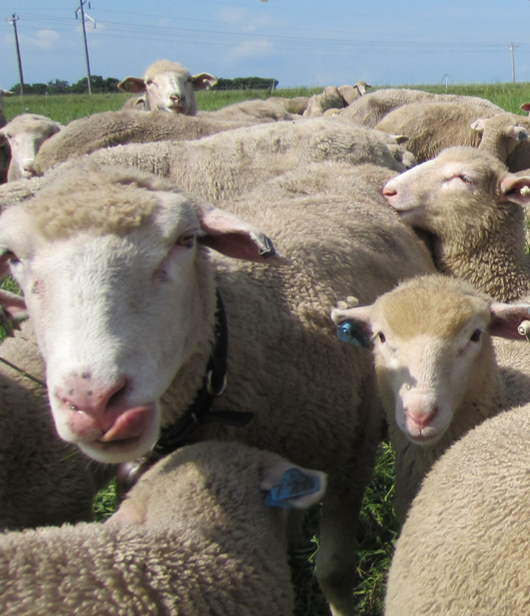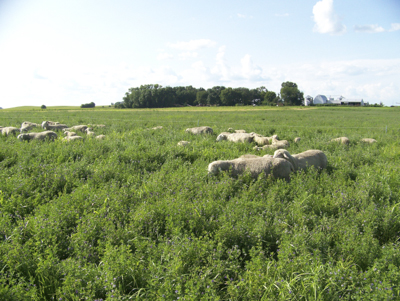Health Benefits of Pasture-Raised Lamb and Beef
“You are what you eat.”
But what does your food eat? What you eat, and therefore what makes you what you are, can only be as good as what your food eats, whether you are talking about spinach or a steak.
So therefore, you are what your food eats.
“But,” you say, “when I look at a bag of spinach, it says that there is this much calcium, this much iron, etc. so that is what spinach is, right?”
But what if I would tell you that that amount of calcium and other minerals could be increased from what it says on the bag? Grow it in healthy soil that has an abundance of available calcium and the calcium content in the spinach will increase. Healthy, biologically active, well-mineralized soil will allow for greater mineral uptake by the plants than poor dead soil.

So think about it again. What does your meat eat? Is your meat eating a variety of plants from healthy, biologically active, well-mineralized soil? Or is it eating corn and processed protein pellets?
Even though red meat is generally agreed to be bad for health, 100% pasture-raised red meat is generally agreed to be beneficial to health. For ruminants such as sheep and cows, a diet of 100% green plants and no grain (often called “grassfed”) is a natural diet, and the resulting meat is a good, healthy food. Most sheep and cows are raised in feedlots with large amounts of grain and processed pellets, and this unnatural diet results in meat that is less than healthy for our bodies.

In our pastures, we focus on improving soil health through plant diversity, rotational grazing, and careful nutrient management to grow the healthiest plants for our sheep and cows to eat. Feeding our cows and sheep right eliminates the need for antibiotics or artificial hormones, and we end up with meat that we feel proud to feed our family. Because of the focus on healthy soil, our meat is nutrient-dense and delicious!

Some unique health benefits of 100% pasture-raised meat include:
High conjugated linoleic acid content
Often abbreviated CLA, conjugated linoleic acid is an essential fatty acid in the fat of 100% fresh pasture-raised animals that has been shown to:
- Help maintain a healthy weight (yes, consuming fat can help with weight!)
- Have anti-cancer properties
- Reduce effects of osteoporosis
- Be anti-diabetic
- Prevent heart disease
- Legumes (clovers) in pastures can increase the CLA content in the meat over pastures that are just grasses. We manage our pastures to maintain a high percentage of legumes.
- CLA is highest in meat from animals eating fresh pasture, not harvested hay, which is another reason that the best grassfed meat is seasonal.
Higher in Omega-3 fatty acids, lower in Omega-6 fatty acids
- Grassfed beef on average has an Omega-3:Omega-6 ratio of 1:1.35, while grain-fed beef on average has a Omega-3:Omega-6 ratio of 1:7.65
- Grassfed lamb can have an Omega-3:Omega-6 ratio of
- The diet of most Americans has a 20:1 Omega-3:Omega-6 ratio
- The ideal dietary balance of Omega-3 to Omega-6 fatty acids should be close to 1:4 according to the American Medical Association and the American Heart Association. Other sources say that it should even be closer to 1:1.
Healthier composition of saturated fats, monounsaturated fats, and polyunsaturated fats
Higher in many vitamins, including vitamins A and E
By eating live plants, our cows and sheep consume more vitamins so they have higher levels in their meat than animals that just ate grain and processed pellets
Higher in many minerals
Minerals are more bioavailable from live plants than from processed pellets.
For our animals in particular, we strive for a high level of mineral nutrition, as this promotes health and vitality in our sheep and cows. We routinely test the livers (a mineral storage organ) of harvested animals to gauge our success in this area.
There are a few important things to consider with pasture-raised meat:
Enjoy the fat!
The health benefits listed above can only be fully realized if you actually eat the fat. Think about it this way: broccoli can reduce your risk of cancer, but if you leave the broccoli on your plate, you won’t realize that benefit! There is a certain amount of fat in the meat (marbling), but the fat around the edges of chops, steaks, roasts, etc. has the same great health benefits. We as a society have been trained so hard with the old food pyramid that fat in general is bad for your health and animal fat is the worst. But more recent research agrees that fat can be heart-healthy, help maintain healthy weight, and that fat from pasture-raised animals is great for health!
100% pasture to the end!
Animals that are fed grain prior to harvest will not have the grassfed health benefits. Even if an animal grazes pasture for most of its life, it is important for them to be eating fresh pasture as they are putting on their final finishing fat. Many supposedly grassfed animals are raised with some grain at the end, so it is important to ask directly if you value the health benefits.
Don’t settle for lean grass-fed meat.
Fat is and should be viewed as an essential nutrient, not something to be avoided, and as noted above, many of the health benefits of 100% pasture raised meat are in the fat. If the meat is lean, it won’t help tip your balance of omega 3s in your favor, you won’t get the anti-cancer properties of CLAs, etc. Again, if you don’t eat your broccoli, you won’t get the health benefits! It takes high quality pastures and careful management to produce well-marbled meat on pasture alone, and many don’t take the extra effort. But it is worth it, as a well-finished and marbled grassfed steak will taste far superior to lean, dry one!
Avoid false grassfed claims.
The way to know for sure how your meat was raised is to visit the farm or talk with the farmer. You may have seen the term “grassfed” in the store, but it is not currently well-regulated, so meat that is labeled as such may actually be partly grain-finished and not have the health benefits of meat from animals raised on 100% forages.
Beware of imported grassfed.
75-80% of meat sold as grassfed is imported from Australia, New Zealand, Brazil, Paraguay and Uraguay. Most of these animals are overgrazing fragile desert regions and destroying that ecosystem in an effort to make a quick dollar from a growing demand for grassfed meat. Even though it is from halfway around the world, it can still be labeled as “Product of USA” because regulations require that it go through a USDA-inspected processing plant. Due to the low quality forage, this meat is also often lean, so you won’t get the full health benefits of grassfed meat. So again, visit the farm or get to know the farmer!
